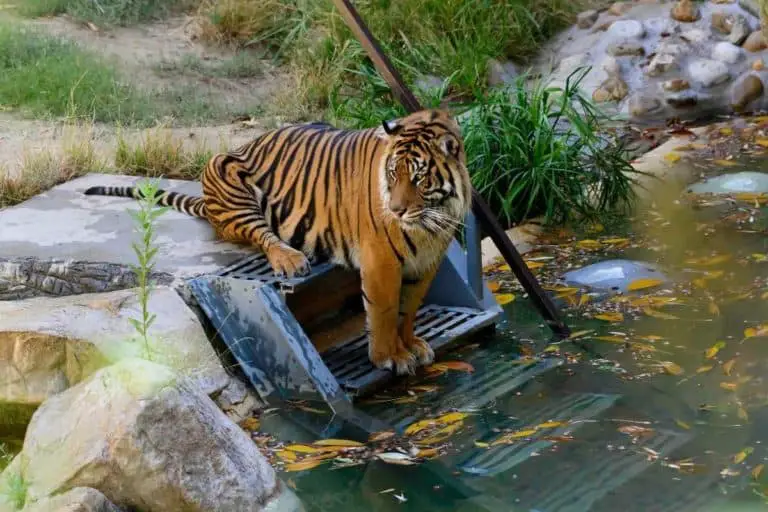Do Tigers Have Predators?
Tigers are apex predators, which means they have no natural predators and are at the top of their food chain. They are also territorial animals, defending their hunting ground against other tigers. This helps them avoid direct competition for food and limits the risk of fights between rival male tigers.
The only predators regularly hunt adult tiger cubs are giant snakes such as pythons. There is evidence that crocodiles will kill young tigers if they catch them drinking at the water’s edge. However, big adult tigers are well-equipped to defend themselves against these reptiles.
Mortality rates in tiger cubs are high due to attacks from other tigers or leopards. When they reach adulthood, tigers live solitary lives and only interact when breeding or territorial disputes.
Tigers have no natural predators themselves, although there is evidence that crocodiles may prey on young tigers.
What Can Kill a Tiger?

Though often described as the most dangerous of big cats, tigers have several predators throughout their range.
In many cases, smaller animals can be just as dangerous to a tiger as another tiger.
Dholes and crocodiles, for example, prey on young or infirm tigers with impunity, while packs of wolves have been known to bring down healthy adults.
Smaller animals can quickly kill young or struggling tigers, such as wild dogs and hyenas.
In captivity, tigers have been known to die from the stress of being confined with other tigers, which they typically would not tolerate in the wild.
However, hunting and trapping by humans account for most tiger deaths worldwide.
Even in large, well-protected parks such as India’s Ranthambore National Park, where 40 tigers lurk within its borders, poaching accounts for a significant percentage of tiger mortality.
Tigers have been known to kill each other, but this typically occurs only when one tiger invades another’s territory.
Do Tigers kill Other predators?
Tigers do not typically kill other predators. Although they often steal their food, there is little documented evidence that tigers attack wolves, leopards, or cheetahs as competitors for the same prey.
In fact, they may benefit from having large carnivores around as these animals will chase off smaller predators from their kills, allowing them more accessible access to their prey.
On the other hand, Bears are one of the tiger’s main competitors for food and will steal tiger kills when possible. Many bears have been reported killed by tigers while trying to eat their kill or getting into a tiger’s den.
Given that most tigers live close to humans, it may come as little surprise that the only predator they commonly hunt is the man.
What animals are tigers afraid of?
Tigers are afraid of creatures that are bigger than they are, such as elephants and particular bears. They often take to trees to escape them.
A crocodile’s sharp jaw may even kill a tiger.
Tigers also can’t swim, so if they got in a fight with an alligator or crocodile in the water, they would not be able to get away.
This is why you never see tigers near the water.
Tigers are also afraid of humans and run when one gets close to them. We shoot them for sport, and they have lost a lot of their habitat to humans, who also kill them for their skin and other reasons.
They’re also terrified of dholes, fierce wild Asiatic dogs that hunt alone or in groups and are robust and tenacious enough to bring down a giant tiger.
Cougars, leopards, and other smaller cats can also beat up tigers in a fight since they are similar in size.
In fact, even an angry honey badger can kill a Siberian tiger. You may have seen a video of one fighting a lion on Youtube. While it didn’t win, the fact that it was able to get away from a lion is a testament to its incredible toughness.
Tigers also fear bears and lions.
What do Tigers hate the most?
Being caged. Their natural habitat is the jungle, where nature supplies all their needs. Tigers will not stay in a cage for long.
So far, I’ve only seen happy tigers when they are walking about freely in their home range, stretching themselves after taking a nap, scavenging for food, or spending time with their cubs.
Unhappy tigers are caged tigers.
Tigers in the wild have lots of natural enemies, unlike tigers in human care who have no need to fear any other predator, making them weak and lazy.
Most tigers in zoos are raised by humans from a cub or born in captivity, making them completely reliant on humans for survival.






